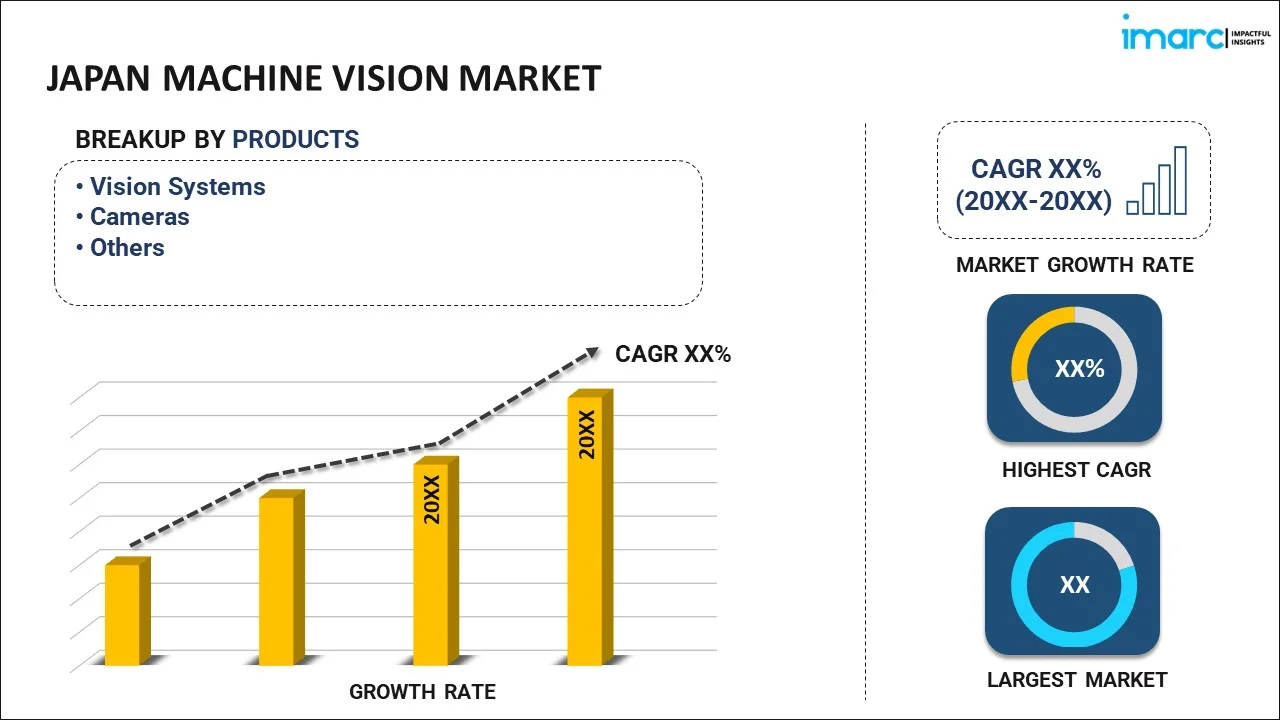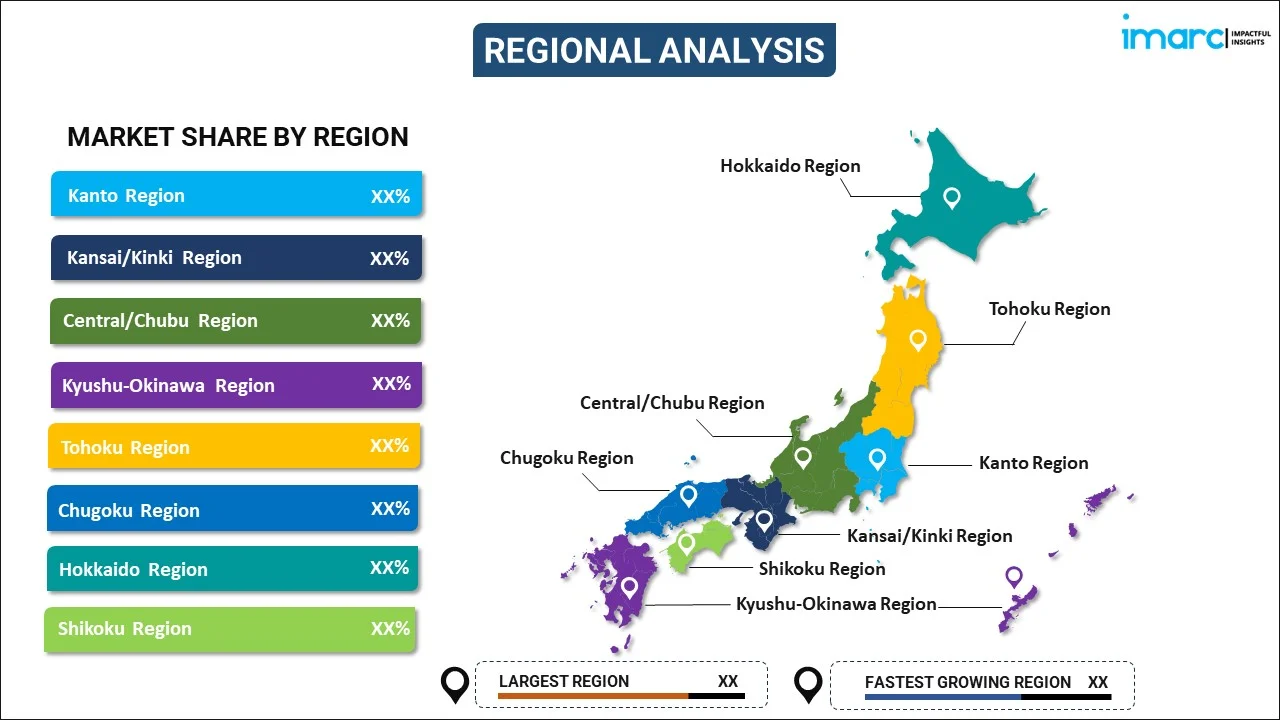
Japan Machine Vision Market Report by Product (Vision Systems, Cameras, and Others), Component (Hardware, Software), Application (Positioning, Identification, Verification, Measurement, Flaw Detection, and Others), Industry (Electronics and Semiconductor, Automotive, Medical and Pharmaceutical, Food, Packaging and Printing, Security and Surveillance, Intelligent Traffic System, and Others), and Region 2025-2033
Market Overview:
Japan machine vision market size reached USD 1,587.3 Million in 2024. Looking forward, IMARC Group expects the market to reach USD 3,455.8 Million by 2033, exhibiting a growth rate (CAGR) of 9.2% during 2025-2033. The ongoing advancements in camera technologies, such as higher resolutions, faster frame rates, and improved sensitivity, which have enabled the development of more sophisticated and high-performance machine vision systems, are driving the market.
|
Report Attribute
|
Key Statistics
|
|---|---|
|
Base Year
|
2024
|
|
Forecast Years
|
2025-2033
|
|
Historical Years
|
2019-2024
|
|
Market Size in 2024
|
USD 1,587.3 Million |
|
Market Forecast in 2033
|
USD 3,455.8 Million |
| Market Growth Rate 2025-2033 | 9.2% |
Machine vision is a field of technology that enables computers to visually perceive, process, and understand images or videos in a manner similar to human vision. It involves the use of cameras, specialized hardware, and software algorithms to inspect, analyze, and make decisions based on visual information. By harnessing techniques such as image processing, pattern recognition, and deep learning, machine vision systems can identify and interpret objects, patterns, and scenes within their visual field. Applications of machine vision span across various industries, including manufacturing, healthcare, robotics, and autonomous vehicles. This technology facilitates tasks such as quality control, product inspection, object recognition, and navigation. With advancements in artificial intelligence and computer vision, machine vision continues to evolve, offering enhanced capabilities for automated decision-making and enhancing the efficiency and accuracy of numerous industrial and commercial processes.
Japan Machine Vision Market Trends:
The machine vision market in Japan is driven by several key factors. Firstly, the rising demand for quality inspection and automation across various industries has significantly propelled the adoption of machine vision systems. Additionally, the increasing need for improved productivity and operational efficiency in manufacturing processes has spurred the integration of advanced machine vision technologies. Moreover, the growing trend of Industry 4.0 and the implementation of smart factory concepts have fostered the deployment of machine vision solutions to enhance production processes and ensure higher precision and accuracy. Furthermore, the expanding application of machine vision in diverse sectors such as automotive, electronics, pharmaceuticals, and food and beverages has played a crucial role in driving the market growth. Furthermore, the advancements in artificial intelligence and deep learning algorithms have augmented the capabilities of machine vision systems, enabling them to perform complex tasks with enhanced accuracy and speed. Lastly, the continuous efforts of key market players to develop cost-effective and high-performance machine vision solutions have further stimulated the market expansion, making it more accessible to a wider range of industries.
Japan Machine Vision Market Segmentation:
IMARC Group provides an analysis of the key trends in each segment of the market, along with forecasts at the country level for 2025-2033. Our report has categorized the market based on product, component, application, and industry.
Product Insights:

- Vision Systems
- Cameras
- Others
The report has provided a detailed breakup and analysis of the market based on the product. This includes vision systems, cameras, and others.
Component Insights:
- Hardware
- Software
A detailed breakup and analysis of the market based on the component have also been provided in the report. This includes hardware and software.
Application Insights:
- Positioning
- Identification
- Verification
- Measurement
- Flaw Detection
- Others
The report has provided a detailed breakup and analysis of the market based on the application. This includes positioning, identification, verification, measurement, flaw detection, and others.
Industry Insights:
- Electronics and Semiconductor
- Automotive
- Medical and Pharmaceutical
- Food, Packaging and Printing
- Security and Surveillance
- Intelligent Traffic System
- Others
A detailed breakup and analysis of the market based on the industry have also been provided in the report. This includes electronics and semiconductor, automotive, medical and pharmaceutical, food, packaging and printing, security and surveillance, intelligent traffic system, and others.
Regional Insights:

- Kanto Region
- Kansai/Kinki Region
- Central/ Chubu Region
- Kyushu-Okinawa Region
- Tohoku Region
- Chugoku Region
- Hokkaido Region
- Shikoku Region
The report has also provided a comprehensive analysis of all the major regional markets, which include Kanto Region, Kansai/Kinki Region, Central/ Chubu Region, Kyushu-Okinawa Region, Tohoku Region, Chugoku Region, Hokkaido Region, and Shikoku Region.
Competitive Landscape:
The market research report has also provided a comprehensive analysis of the competitive landscape. Competitive analysis such as market structure, key player positioning, top winning strategies, competitive dashboard, and company evaluation quadrant has been covered in the report. Also, detailed profiles of all major companies have been provided.
Japan Machine Vision Market Report Coverage:
| Report Features | Details |
|---|---|
| Base Year of the Analysis | 2024 |
| Historical Period | 2019-2024 |
| Forecast Period | 2025-2033 |
| Units | Million USD |
| Scope of the Report | Exploration of Historical and Forecast Trends, Industry Catalysts and Challenges, Segment-Wise Historical and Predictive Market Assessment:
|
| Products Covered | Vision Systems, Cameras, Others |
| Components Covered | Hardware, Software |
| Applications Covered | Positioning, Identification, Verification, Measurement, Flaw Detection, Others |
| Industries Covered | Electronics and Semiconductor, Automotive, Medical and Pharmaceutical, Food, Packaging and Printing, Security and Surveillance, Intelligent Traffic System, Others |
| Regions Covered | Kanto Region, Kansai/Kinki Region, Central/ Chubu Region, Kyushu-Okinawa Region, Tohoku Region, Chugoku Region, Hokkaido Region, Shikoku Region |
| Customization Scope | 10% Free Customization |
| Post-Sale Analyst Support | 10-12 Weeks |
| Delivery Format | PDF and Excel through Email (We can also provide the editable version of the report in PPT/Word format on special request) |
Key Questions Answered in This Report:
- How has the Japan machine vision market performed so far and how will it perform in the coming years?
- What has been the impact of COVID-19 on the Japan machine vision market?
- What is the breakup of the Japan machine vision market on the basis of product?
- What is the breakup of the Japan machine vision market on the basis of component?
- What is the breakup of the Japan machine vision market on the basis of application?
- What is the breakup of the Japan machine vision market on the basis of industry?
- What are the various stages in the value chain of the Japan machine vision market?
- What are the key driving factors and challenges in the Japan machine vision?
- What is the structure of the Japan machine vision market and who are the key players?
- What is the degree of competition in the Japan machine vision market?
Key Benefits for Stakeholders:
- IMARC’s industry report offers a comprehensive quantitative analysis of various market segments, historical and current market trends, market forecasts, and dynamics of the Japan machine vision market from 2019-2033.
- The research report provides the latest information on the market drivers, challenges, and opportunities in the Japan machine vision market.
- Porter's five forces analysis assist stakeholders in assessing the impact of new entrants, competitive rivalry, supplier power, buyer power, and the threat of substitution. It helps stakeholders to analyze the level of competition within the Japan machine vision industry and its attractiveness.
- Competitive landscape allows stakeholders to understand their competitive environment and provides an insight into the current positions of key players in the market.
Need more help?
- Speak to our experienced analysts for insights on the current market scenarios.
- Include additional segments and countries to customize the report as per your requirement.
- Gain an unparalleled competitive advantage in your domain by understanding how to utilize the report and positively impacting your operations and revenue.
- For further assistance, please connect with our analysts.
 Inquire Before Buying
Inquire Before Buying
 Speak to an Analyst
Speak to an Analyst
 Request Brochure
Request Brochure
 Request Customization
Request Customization




.webp)




.webp)












